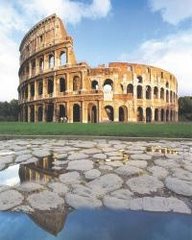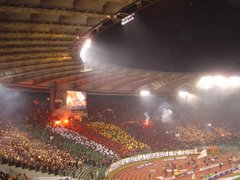Along the Tiber
This itinerary unwinds along the Tiber, always a characteristic element of the Roman landscape. Up until the construction of the embankments, in the late 19th century, it was completely navigable and characterised by an unending sequence of buildings that faced onto and were reflected in the water.
The river was used for fishing and bathing; the water was used to drink and for motive power.
Today, from late spring through early autumn, an atmospheric river navigation service between the Ponte del Foro Italico and Ponte Umberto I (tel. 064463481) is offered. On the other hand, for bicycle lovers there is a bike lane between Ponte Flaminio and Ponte Risorgimento.
Our walk starts from the Isola Tiberina, which was of exceptional importance in the history of the birth and development of Rome.
In fact, starting in extremely ancient times, the island's presence facilitated the crossing of the river, leading to the building of the first permanent settlements on the surrounding high ground.
According to ancient tradition, the island was allegedly formed in the late 6th century A.D. after the Etruscan kings were driven from Rome, when the people threw into the river, out of contempt for the monarchy, the wheat harvested on the royal properties of Campus Martius. Another legend tells of a large boat grounded in the middle of the river during a flood, and later filled up with sand transported by the current.
In reality the island is situated on an ancient volcanic rock core similar to that on which the nearby Capitol stands, but the shape actually does seem to resemble a ship. This did not escape the attention of the Romans who, in the 1st century B.C., accentuated the shape, modelling the island's sides with travertine and raising an obelisk in the centre, like a majestic mast. This "stone ship" was meant to commemorate the healthful ship of Aesculapius, the god of medicine, and his miraculous intervention.
Legend has it that in the 3rd century B.C., during a plague, the Romans went by ship to Epidaurus, in Greece, to learn from the god Aesculapius how to escape the scourge. But when the returning ship was ascending the river, the god's sacred serpent slipped out of it, at the point where the island was, indicating that that island was to be consecrated to him.
The construction of a building sacred to the god Aesculapius, where the present-day church of San Bartolomeo now stands, determined the definitive destination of the island to a place of medical treatment, also facilitated by its position segregated from the residential centre. Today, still, the Fatebenefratelli Hospital is the building which occupies the island almost entirely, characterising it deeply.
A historic trattoria of the isola Tiberina is Sora Lella, at Via di Ponte dei Quattro Capi 16, which belonged to the sister of Roman actor Aldo Fabrizi.
The island is connected to the mainland by two bridges: the Cestio, connecting it with the Trastevere bank, and the Fabricio, or Ponte dei Quattro Capi, which was built in 62 B.C. and is the oldest bridge in Rome which has arrived to us practically intact. From the island it is also possible to see a third bridge, the Ponte Rotto, which collapsed in the late 16th century. In the past the Ponte Fabricio was called Ponte dei Giudei (Bridge of Jews) because it joined the Isola Tiberina to the area of the Ghetto where Rome's Jews lived.
The term "Ghetto" is used to indicate the quarter lying between Monte dei Cenci and the Theatre of Marcellus, lying entirely within the Sant'Angelo district. It was founded by Pope Paul IV Carafa in 1555, and abolished only in 1870, with the end of the Church State. It was surrounded by a wall in which there were three gates, opened in the morning and closed at dusk. In an area of approximately three hectares, in the 17th century around 9,000 inhabitants lived there in frightful sanitary conditions.
The Ghetto faces onto the Lungotevere Cenci with the monumental building of the Synagogue, built in 1904,today also the seat of the Israelite Museum of the Jewish Community of Rome.
Behind the Synagogue runs the Via del Portico d'Ottavia, which owes its name to the ruins of the ancient portico built at the end of the 1st century B.C. by the Emperor Augustus for his sister.
Inside part of the monument stands the church of Sant'Angelo in Pescheria, so-called in reference to the important fish market held here from the Middle Ages up to the end of the 19th century. The stone tablet used in the market to remind customers of the obligation to give the Municipal Magistrates the heads of any fish whose length was longer than that of the tablet itself is still there.
The church of Sant'Angelo was one of the four churches where Jews had to go every Saturday with the obligation of listening to the sermons aiming to convert them. It was possible to avoid doing so by paying a fine, but more often the Jews preferred to fill their ears with wax!
Today the Ghetto is one of the zones of Rome which, more than any other, has kept the physiognomy, aromas, and flavours of the old city: for a taste of the specialities of authentic Roman and Jewish cooking - carciofi alla giudia (crisp-fried whole artichokes), filetti di baccalà (fried fillets of salted cod), coda alla vaccinara (braised oxtail "butcher" style) - we recommend the trattorias Giggetto, at Via del Portico d'Ottavia 21a/22 (tel. 06-6861105), and Al Pompiere, at Via Santa Maria dei Calderari 38 (06 6868377). Also make a stop at Boccione, Via del Portico d'Ottavia 1, for cakes, pastries, and unleavened bread baked in the best Roman-Jewish tradition.
Continuing the itinerary southward, we reach the zone of the Foro Boario, the site in ancient times of the cattle and beef market, and the Velabrum, once a stagnant marsh where, according to tradition, the basket with the twins Romulus and Remus was found.
The sons of Mars and Rhea Silvia, the twins were saved by a she-wolf who nursed them. For this reason the she-wolf has become one of the symbols of the city of Rome.
Dominating monuments in the area are the two famous Temples called of Vesta (the one with a circular plan, in reality dedicated to Hercules Victor) and of Fortuna Virilis (in reality dedicated to the river god Portumnus). Following is the church of Santa Maria in Cosmedin dating from the 6th century and entrusted later to the Greeks who had fled to Rome from the East. In fact, the church's name comes from the Greek, referring to the splendid decorations characterising it.
Here, each Sunday at 10.30 a.m., a Greek-Orthodox mass is held.
Beneath the portico, of the church, to the left, is the famous Bocca della Verità (Mouth of Truth), a large stone disk depicting the face of a faun or river god, with its mouth open. It is probably a monumental slab to close a drain but, according to legend, the stone was used to judge people's honesty: whoever told a lie while holding his hand in the mouth would have ended up pulling out only the stump.
Audrey Hepburn and Gregory Peck also fell subject to its mysterious charm in the famous film Roman Holiday!
At this point the walk continues towards Castel Sant'Angelo, northward; we can either continue on foot or take a bus.
If, on the other hand, we want to take a short break, on the other side of the Tiber, at the entrance to Ponte Cestio, we can enjoy one of the most famous "grattacecche" (water ices) in Rome.
Castel Sant'Angelo was built in the early 2nd century by the Emperor Hadrian, as a monumental tomb for himself and his successors.
It is connected to the left bank of the Tiber by Ponte Elio, today's Ponte Sant'Angelo, decorated with ten marble statues of angels with the symbols of the passion of Christ, carved after a design by Gian Lorenzo Bernini. The monument's fate was decided in 403, when the Emperor Honorius incorporated it into the city walls, making it into a bridgehead on the river. From the 13th century it became an "annexe" of the nearby Vatican, and Pope Nicholas III created the famous "Passetto di Borgo", a covered corridor connecting St. Peter's to the Castle.
The fortress became famous down through time, especially as a prison; here Benvenuto Cellini and the famous adventurer Giuseppe Balsamo, known as the Count of Cagliostro, were imprisoned.
The name with which the fortress is known derives from a miraculous event which took place in 590: Rome was in the midst of a severe plague, and Pope Gregory the Great had organised a solemn procession to pray for its end. When the procession reached the Mole of Hadrian, Archangel Michael was seen flying up and sheathing his flaming sword, symbolising the end of the plague. The statue of the angel, placed on the top of the castle to commemorate the event, was replaced six times.
Leaving Castel Sant'Angelo behind us and again going along the Tiber, we go past the Palace of Justice and reach Ponte Cavour, on the other side of which is the Ara Pacis.
The altar of peace was ordered by Augustus to celebrate the peace in the Empire after the conquests of Gaul and Spain. The monument, which originally stood near the present-day Via in Lucina in the Campus Martius quarter, was moved here in 1938. Before the altar is the Mausoleum built by Augustus as a tomb for himself and his family.
The monument, which fell into abandon, was at various times used as a vineyard, a garden and, in the late 16th century, an area for tournaments and bullfights. At the end of the 19th century it was called "Anfiteatro Umberto", and from 1905 to 1930 it was a concert hall called "Augusteo". At the end of the 1930s the monument was separated from its surroundings, with the creation of the large piazza Augusto Imperatore.
Right on the piazza, at no. 9, we recommend the restaurant 'Gusto (06 3226273), with extremely refined cuisine and decor; on Saturdays and Sundays it is also open for lunch. Also, for excellent fettuccine, at no. 30 there is Alfredo all'Augusteo (06 6878734).
Length of itinerary: entire day.
Practical information: Synagogue and Jewish Museum, open from 9 a.m. to 4.30 p.m., Fridays from 9 a.m. to 1.30 p.m., Sundays from 9 a.m. to noon, closed Saturdays.
Castel Sant'Angelo, open from 9 a.m. to 6 p.m., closed Mondays.
Water in Rome
Undoubtedly there is no city in the world that has more waters and fountains than Rome. It has been thus since ancient times, when 11 aqueducts supplied thousands and thousands of litres of water to the city each day, feeding the countless fountains and magnificent baths. The sacking of the Goths, resulting in the cutting of the aqueducts, ended this richness, and only at the end of the 16th century did the popes tackle the water supply problem adequately. Since then Rome was adorned with dozens of monumental fountains celebrating the pontiffs' munificence, often flanked by drinking troughs and public basins for practical uses. And today still, while we admire these masterpieces, we refresh ourselves by drinking the excellent water running from the typical drinking-water fountains affectionately called "nasoni" - big noses - because of the curious shape of the curved spout.
The theatrical Fountain of the Naiads, one of the most beautiful fountains of modern Rome, is the work of sculptor Mario Rutelli, who created it in 1901 to adorn Piazza della Repubblica, originally called Piazza Esedra.
The old name derives from the fact that the square was created, in the late 1900s, following the curved line of the large exedra of the majestic Baths of Diocletian, recently restructured and reopened to the public. Between the two semicircular porticoed buildings opens Via Nazionale, an important main street and lively commercial zone. At no. 194 is the Palazzo delle Esposizioni, the site of interesting exhibitions.
The roof garden is one of the most popular places in Rome for short snacks, lunches, or mundane and cultural events.
The four bronze nymphs placed around the basin of the Fountain of the Naiads were the subject of fierce controversy, which led to the raising of a fence to prevent the sight of the female figures, considered too sensual because of the manner in which they were embracing the sea monsters. The fence was removed by popular acclaim, but the criticism did not end, so the sculptor created the central group which, depicting three tritons, a dolphin and an octopus, was quickly christened "mixed fish fry". The group was transferred to Piazza Vittorio and replaced with the figure of Glaucus Fighting a Triton.
For those with a sweet tooth a stop at the Dagnino bar-pastry shop, Via V. Emanuele Orlando 75, is a must. It offers the best Sicilian specialities, from cannoli to marzipan fruit. Those, on the other hand, in search of guidebooks or other books can go to Feltrinelli International, Via V. Emanuele Orlando 84, or Mel Book Store, Via Nazionale 255.
Often the creation of aqueducts and fountains was dictated, more than by the desire to meet the population's needs, by the desire to satisfy private interests of the popes. This is the case of the Fountain of Moses in Piazza San Bernardo, which forms the "display", i.e. the terminal part of the Felice aqueduct, thus named after Pope Sixtus V, Felice Peretti, who restored the ancient Alessandrino aqueduct.
This was done mainly to serve the huge villa, which no longer exists, that the pope had built starting in 1585 and which occupied the entire Termini Station area as far as the Basilica of Santa Maria Maggiore. The figure of Moses as he makes water gush forth from the rock, an obvious reference to the pope who restored the aqueduct, was so strongly criticised for its lack of elegance and proportion that it became the subject of a humorous pasquinade:
Guarda con l'occhio torvo
l'acqua che sgorga ai piè,
pensando inorridito
al danno che a lui fè
uno scultor stordito.
(He looks with a surly eye
at the water gushing at his feet
thinking, horrified,
of the damage done to him
by a dazed sculptor.)
Going down Via Barberini we reach the square of the same name, characterised by the lovely Triton's Fountain, a masterpiece by Gian Lorenzo Bernini, who created it in around 1642.
The whimsical composition, which decorated the square in front of the palace of the noble Barberini family (see Itinerary 11), depicts a triton held up by four dolphins as he is blowing into a shell, proclaiming the family's glory to the world. Up until the 18th century a macabre ritual would take place in front of the fountain: the corpses of the unknown would be shown there as a crier would call for them to be recognised.
At no. 120 of Via del Tritone is Planet Hollywood, part of the chain of restaurants opened all over the world by a company formed by a group of famous American movie actors including Sylvester Stallone and Arnold Schwarzenegger.
Bees, the heraldic symbol of the Barberini, in addition to decorating the base of the Triton's Fountain, are the protagonists of a small but lovely composition placed at the corner between Piazza Barberini and Via Veneto, the Fountain of the Bees.
The three insects, situated on thehinge of an open bivalve shell, were sculpted by Bernini in 1644, to celebrate the twenty-second anniversary of the papacy of Pope Urban VIII. The fact that he finished it before the actual date of the anniversary seems to have been a bad omen for the pontiff, who unfortunately died eight days before it.
From here starts Via Veneto, "twinned" with Fifth Avenue in New York, the symbol of the Dolce Vita of the '50s and 60s.
The elegant street, celebrated by Federico Fellini, is the hangout of politicians, intellectuals, entertainers and journalists, often immortalised by the ever-present "paparazzi". Renowned the world over are its luxurious hotels, the Excelsior, the Majestic, the Ambasciatori and the Regina Palace, and its famous cafés, such as Cafè de Paris, Doney and Harry's Bar. Across from the American Embassy, a Hard Rock Cafè has also been opened recently.
The entire quarter was created between the late 1800s and the early 1900s, when the Boncompagni Ludovisi princes decided, with an unscrupulous action of real estate speculation, to divide the land belonging to their 17th-century splendid villa into lots. Of the villa, only the Casino dell'Aurora (on Via Boncompagni), decorated by Guercino and Caravaggio, remains, and unfortunately it is not easily accessible.
From Via del Tritone we enter Via della Stamperia, which leads to the Trevi Fountain, certainly the most famous and spectacular fountain in Rome, made even more famous by the night-time wading of Anita Ekberg in Federico Fellini's film La dolce vita.
The fountain is the terminal part of the Vergine aqueduct built by Agrippa, a general of Augustus, in 19 B.C. to bring the water coming from the Salone springs, 19 km away, to Rome.
Legend, illustrated in the fountain's upper panels, has it that it was a young girl who showed Agrippa's thirsty soldiers where a copious spring gushed forth. Hence the name of the aqueduct which, running underground for a long stretch, is the only one in Rome that has remained in use almost uninterruptedly from the time of its construction to the present day. This is the aqueduct that supplies the water to the monumental fountains of the historic centre, from Piazza Navona to Piazza di Spagna.
The name "Trevi", on the other hand, allegedly derives from the word Trivium, a meeting point of three streets that form this little widened area.
It is truly surprising to see such a large fountain in such a small square, but the artist Nicola Salvi, who created it between 1732 and 1762, carefully studied the way to increase the sensation of marvel. Indeed, he set it almost entirely against the face of Palazzo Poli, preceding it with a little balconied scene, almost as if it were a theatre! The artist was, however, disturbed during his work by the continuous criticism expressed by a barber who had his shop in the square. To shut him up, during one night Salvi created the large basin, familiarly called the "Ace of Cups", situated on the right-hand balustrade, which completely blocked the view of the fountain from the shop. Everyone knows that, if they want to return to Rome, they have to throw a coin into the basin, but be careful: for the dream to come true, you have to toss it over your shoulder with your back to the fountain!
Across from the fountain it is possible to admire the lively façade of the Chiesa dei Santi Vincenzo e Anastasio.
The building, which was a Papal Parish for centuries, preserves the hearts and lungs of 22 popes who died in the Quirinal Palace standing nearby (see Itinerary 9): from Sixtus V, who died in 1590, to Leo XIII, who died in 1903. Pope Pius X abolished this custom which had prompted Belli, the famous Roman dialect poet, to call the church "museo de' corate e de' ciorcelli" (pluck museum), from the popular term used to refer to the viscera of butchered animals.
Returning onto Via della Stamperia and continuing along Via del Nazareno, we soon reach Piazza di Spagna (see Itineraries 8 and 14) where, at the foot of the staircase of Trinità dei Monti, the "Spanish Steps", we find the Fontana della Barcaccia.
This is the work of Pietro Bernini, who created it in around 1629, probably with the aid of his famous son Gian Lorenzo. According to tradition, the unusual fountain shaped like a semi-submerged boat was ordered by Pope Urban VIII Barberini to commemorate a boat that had ended up stranded in the square during the great flood of 1598. In reality, the idea of depicting the boat as it is sinking was dictated by Bernini's genius, since he had to solve a technical problem: in fact, here the pressure of the Vergine aqueduct was rather low, and it was necessary to create a fountain beneath the ground level.
From Piazza di Spagna starts Via del Babuino, famous for its antique shops, which owes its name to a small fountain against the Church of Sant'Atanasio dei Greci.
The ancient statue overlooking the granite basin depicts a supine, sneering wanderoo but the Romans, because of its ugliness, compared it to a monkey or, more exactly, a baboon. It is said that a cardinal, a bit on in years, would kneel down before it in respect every time he passed by, believing it to be the portrait of St. James. The Baboon is one of Rome's "talking statues", where satirical pieces and diatribes of a political nature, strictly anonymous, used to be posted (see Itinerary 10).
Parallel to to Via del Babuino runs Via Margutta which, since the 1600s, Italian and foreign artists have chosen as the picturesque location for their studios.
Although it is no longer as it once was, the street has preserved a considerable charm, also thanks to the presence of shops such as "Marmoraro", at no. 53, where marble is still worked using traditional artisan techniques and old tools. The pretty Fountain of the Artists, near n. 54, was created in 1927 by Pietro Lombardi precisely to recall this peculiarity, since it depicts easels, stands, paintbrushes, and palettes.
This original composition is one of the "Fontanelle Rionali " series, created starting in 1927 by architect Pietro Lombardi. Each quarter of Rome is represented by one or more objects symbolising that neighbourhood - the pinecone for Rione Pigna (Piazza San Marco), the papal tiara for the Vatican (Largo del Colonnato), amphorae for the Testaccio (Piazza Testaccio), the helm for Rione Ripa (Lungotevere Ripa), and so on - all harmoniously inserted into their surrounding contexts.












